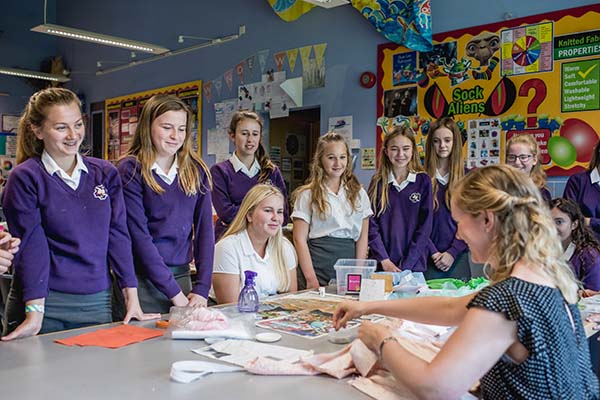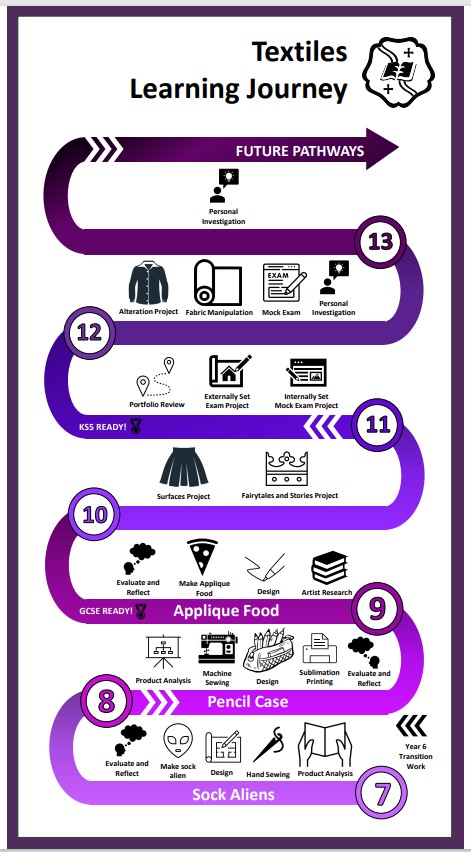
Art, Design and Technology subjects sit in the
curriculum to develop students practical hands-on learning experience. Students
develop the skills to be independent and creative developing their knowledge of
both technical and life skills. Our curriculum is one that offers something for
all, where diversity and individuality is celebrated, and personal outlet is
encouraged and embraced.
At KS3 students learn a variety of different textile techniques as well as the properties and characteristics of fibres and fabrics, fabric construction and modelling. Each year the knowledge is built on with students learning how to design to a brief, consider the needs of different clients and how to create a variety of textile products.

The Textile Design is defined as the creation of designs and products for woven, knitted, stitched, printed or decorative textiles that might have a functional or non-functional purpose. The course encompasses surface pattern and embellishment, fashion design and illustration, costume design, sculptural textiles, installed textiles and art textiles.
Component 1: Portfolio 60% of overall marks
Each student must select and present a portfolio representative of their course of study.
The portfolio must include both:
A sustained project developed in response to a subject, theme, task or brief evidencing the
journey from initial engagement with an idea(s) to the realisation of intentions. This will give
students the opportunity to demonstrate, through an extended creative response, their ability to
draw together different areas of knowledge, skills and/or understanding from across their course of study.
A selection of further work resulting from activities such as trials and experiments; skills-based
workshops; mini and/or foundation projects; responses to gallery, museum or site visits; work
placements; independent study and evidence of the student’s specific role in any group work
undertaken.
Component 2: Externally set assignment 40% of overall marks.
AQA will provide a separate externally set assignment for each title, each with seven different starting points. Students must select and respond to one starting point from their chosen title.
The externally set assignment provides students with the opportunity to demonstrate, through an
extended creative response, their ability to draw together different areas of knowledge, skills and/or understanding in response to their selected starting point.
The extended creative response must explicitly evidence students’ ability to draw together different areas of knowledge, skill and/or understanding from initial engagement with their selected starting point through to their realisation of intentions in the 10 hours of supervised time.
Students must ensure that the total submission for Component 2 evidences coverage of all four
assessment objectives and evidence of drawing activity and written annotation. Students must identify and acknowledge sources which are not their own.
Externally set assignments will be available to students and teachers from 2 January.
A preparation period which can begin on or after 2 January is followed by 10 hours of supervised
unaided work in which students are required to realise their intentions. Students must not undertake any further preparatory studies once the first period of supervised time starts.
Areas of study
In Component 1 and Component 2 students are required to work in one or more area(s) of textile
design, such as those listed below:
•Art Textiles
•Fashion design and illustration
•Costume design
•Constructed textiles
•Printed and dyed textiles
•Surface pattern and/or embellished textiles
•Soft furnishings and/or textiles for interiors
•Digital textiles
•Installed textiles
They may explore overlapping areas and combinations of areas.
Exam Board: AQA
Qualification Title: Textile Design
Qualification Specification Code: 8204
Qualification Webpage: Click here to visit the AQA webpage for the specification.
This vibrant and dynamic GCSE course, gives students the freedom to immerse in the wider world or Textile Design in ways that will inspire and bring out the best in all our students. The course equips students with the skills to continue the subject with confidence at AS, A Level and beyond.
The course allows for progression from KS3, whilst providing a strong foundation for further study at degree level and various vocational pathways.
Students must demonstrate they have a genuine passion for Textiles and Design with an inquisitive, creative mind and the desire to further their knowledge and understanding within the subject. It is essential that they enjoy working in a wide variety of materials with the ability to take risks and work independently.

The exams and non-exam assessment will be measured on how students have achieved the following Assessment Objectives:
AO1: Develop ideas through investigations, demonstrating critical understanding of sources.
AO2: Refine work by exploring ideas, selecting and experimenting with appropriate media, materials, techniques and processes.
AO3: Record ideas, observations and insights relevant to intentions as work progresses.
AO4: Present a personal and meaningful response that realises intentions and demonstrates understanding of visual language.
Marks for both Portfolio and Externally Set Assignment are marked out of 96 marks.
The skills learnt throughout the course will equip students for future creative career paths, such as: fashion designer, costume designer, textile artist, printmaker are a few to mention. A CGSE in an Art and Design based subject will also provide a sound background for other less obvious careers where the ability to think differently and creatively gives an individual the edge on the competition. Self-expression is actively encouraged throughout students’ work; the written work and discussion are all encouraged and important in the development of knowledge and understanding about the wider world of Textile Design. These are valuable tools for all aspects of future life. The Art and Design Department is committed to providing a diverse, innovative course/s, which will provide a rewarding and exciting element to student’s future creative pathways.
The Textiles Design
course complements the GCSE Art and Design courses offered in Graphics,
Textiles Design and Fine Art. It is recommended that one of the following
courses has been successfully completed at GCSE, to maintain the high demand of
work and independence required to study the course. Students will produce
practical and critical/contextual work in one or more areas of study, for
example: Fashion Design, Fashion Textiles, Costume Design, Digital Textiles,
Printed and Dyed Fabrics and Materials, Domestic Textiles, Wallpaper, Interior
Design, Constructed Textiles, Art Textiles and Installed Textiles. The course
will comprise of a personal investigation, which will include written material
around a student’s individual artwork and chosen line of enquiry. This will
include a structured, extended response of between 1000 and 3000 words of
continuous prose. Each student’s investigation will be an in-depth study that
demonstrates the student’s ability to construct and develop a sustained line of
reasoning from an initial starting point to a final realisation. There is also
an externally set practical assignment including a development period from the
1st February, plus a 15 hour supervised examination.
Exam Board: AQA
Qualification Title: Textiles
Qualification Specification Code: 7204
Qualification Webpage: Click here to visit the AQA webpage for the specification.
Standard Sixth Form entry requirements

Art related
degrees, Professional Artist, Printmaker, Clothing or Textile Technologist,
Colour Technologist, Interior and Spatial Designer, Fashion and Costume
Designer, Textile Designer. Students will develop the independent skills
required to move onto Further or Higher Education or moving into the Design
Industry. The course encourages students to develop their own style as an
Artist, whilst covering the requirements of the four assessment objectives.
Mrs Stoodley

Owned by: MDS | Last Published: 20/09/2019 09:53:36 | Next Update: N/A